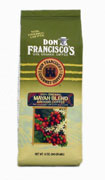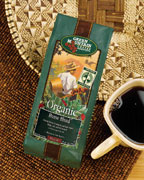|
JAVA GOES ORGANIC
From a Preferred Timeless Classic to a Health Inspired Favorite
by Bonnie Carroll
 The word coffee is derived from the Italian caffe, and designates a stimulating drink. During World War II a scarcity of coffee caused it to become a priceless commodity and it is considered to be the most popular drink in America, along with Coca Cola. The word coffee is derived from the Italian caffe, and designates a stimulating drink. During World War II a scarcity of coffee caused it to become a priceless commodity and it is considered to be the most popular drink in America, along with Coca Cola.
 The caffeine buzz got started during the 17th century when French high society began serving coffee after their meals. By 1800 coffee drinking in France was a set custom in all social levels and coffee became a staple on the military rations roster. Jus, a French slang term for French black coffee became a familiar word used to describe coffee at the close of the 19th century. The caffeine buzz got started during the 17th century when French high society began serving coffee after their meals. By 1800 coffee drinking in France was a set custom in all social levels and coffee became a staple on the military rations roster. Jus, a French slang term for French black coffee became a familiar word used to describe coffee at the close of the 19th century.
The 90s initiated a specialty coffee phenomena, which began in Seattle in the 80s, and slowly inched its way to California cities like Los Angeles and San Francisco. Boyd Coffee, Seattle’s Best, Starbucks, Diedrich and countless others have become household names, and their coffee products are now enjoyed nationally and throughout Europe.
 Today organic rules, and coffee growers are no exception. The new and exciting organic coffee options are delicious and abundant. When the specialty coffee craze hit in the 90s some skeptics said “oh, this won’t last” but not only did the early coffee producer/marketing teams ride the ‘coffee wave’ of success all the way, but they are now providing health conscious patrons a selection of organic sips. These trendy new organic coffee blends are popping up online and at popular health markets everywhere. If you’re not familiar with any of these exciting product options, I have collected a few new items you may want to look for on your next shopping trip or on your next online visit. Today organic rules, and coffee growers are no exception. The new and exciting organic coffee options are delicious and abundant. When the specialty coffee craze hit in the 90s some skeptics said “oh, this won’t last” but not only did the early coffee producer/marketing teams ride the ‘coffee wave’ of success all the way, but they are now providing health conscious patrons a selection of organic sips. These trendy new organic coffee blends are popping up online and at popular health markets everywhere. If you’re not familiar with any of these exciting product options, I have collected a few new items you may want to look for on your next shopping trip or on your next online visit.
Stomping Grounds, www.stompingrounds.com., the creators of Oregon Chai, is now offering four delicious flavors of “cold press espresso concentrate” that allows you to create your own latte at home without the mess or the purchase of an expensive machine. Flavors include vanilla, caramel, espresso and mocha.
 Jim’s Organic Coffee, www.jimsorganiccoffee.com, offers blend X (aka) Witches Brew, Jo-Jo-s Java, band Costa Rican La Amistad blends that are organic and a great addition for coffee aficionados. Jim’s Organic Coffee, www.jimsorganiccoffee.com, offers blend X (aka) Witches Brew, Jo-Jo-s Java, band Costa Rican La Amistad blends that are organic and a great addition for coffee aficionados.
Don Francisco, www.donfrancisco.com, has premiered 100% organic French Roast and Mayan Blend ground coffees that are fresh and delicious. These products are available at most grocery stores.
 Green Mountain Coffee Roasters, www.greenmountaincoffee.com, are proud of their Wild Oats organic Wild Blend and French Roast that provide a great morning beverage or a wonderful ending with desserts. Green Mountain Coffee Roasters, www.greenmountaincoffee.com, are proud of their Wild Oats organic Wild Blend and French Roast that provide a great morning beverage or a wonderful ending with desserts.
 Arbuckles Organic Coffee Roasters produce French Roast and Espresso Blends that really make a difference one cup at a time by creating a product designed to raise funds for the Café Fermenino Project, which helps abused women in third world countries like Peru. Café Feminino is available by the pound or in 2.5 oz 1 pot packets. Visit www.arbucklescoffee.com. Arbuckles Organic Coffee Roasters produce French Roast and Espresso Blends that really make a difference one cup at a time by creating a product designed to raise funds for the Café Fermenino Project, which helps abused women in third world countries like Peru. Café Feminino is available by the pound or in 2.5 oz 1 pot packets. Visit www.arbucklescoffee.com.
No matter if you are enjoying a morning coffee at your favorite franchise, or relaxing with an afternoon cup of organic blend in the office, the truth is that coffee is here to stay, and whether you are sipping yours from a saucer, or slamming it down behind the wheel, the popularity of coffee seems never ending as the growers and their marketing teams strive to meet the individual needs of every member of the coffee loving public.
QUESTIONS ON MAD COW DISEASE
From the Editors of E/The Environmental Magazine
Dear EarthTalk: What is the significance of the recent discovery of a cow in Alabama having Mad Cow disease? Isn't that the very first in North America? Should we be worried? Chris Carroll, Austin, TX
Actually, Mad Cow Disease, technically known as Bovine Spongiform Encephalopathy (BSE), was first detected in North America in January 1993, when a beef cow that had been imported from Britain to the Canadian province of Alberta tested positive. The Canadian government destroyed that particular cow, as well as its entire herd, in order to quell the potential spread of the disease.
Federal agricultural agencies in both Canada and the United States then stepped up testing for BSE coast-to-coast while imposing stricter import criteria for cows coming in from abroad. And since the disease spreads not from direct cow-to-cow contact but only through consumption of infected feed, both countries banned rendered cow remains from being added to cattle feed beginning in 1997.
The redoubled efforts seemed to pay off, as another case of BSE didn't show up in North America for a decade. But then in May 2003, veterinary officials in Alberta confirmed another case, but this time involving a cow born in Canada. Seven months later, American officials announced the first case of BSE in the U.S., when the remains of a deceased cow from a farm in Washington State tested positive.
Regulators feared that some meat may have made its way into supermarkets, which in turn sparked a wave of mad cow hysteria, including import bans on American beef by some foreign countries. Records showed that the cow had been born in Canada, leading to cross-border finger pointing. But when the disease showed up in a Texas cow in June 2005, and then again recently in an Alabama cow, Americans stopped blaming Canada and began looking to stem the spread of the disease within U.S. borders.
BSE, a fatal disease of the nervous system of cattle, first appeared in the United Kingdom in the mid-1980s and then spread across Europe, peaking at almost 1,000 new cases per week in 1993. In 1996, variant Creutzfeldt-Jakob Disease (vCJD), an offshoot of BSE, was detected in humans and linked to the eating of meat and cattle products contaminated with BSE. Fewer than 200 cases of vCJD, all originating in Western Europe, have been detected since the human disease was first identified.
Despite assurances by both Canadian and U.S. officials that BSE cases in recent years have been isolated ones and that North American beef is fit for human consumption, some skeptics aren't so sure. “This disease is endemic in U.S. herds,” says News Target health and wellness columnist Mike Adams. “It is circulating in cows right now and there are almost certainly cows infected with mad cow disease that are being slaughtered and used in the human food supply,” he adds. Adams is worried that the millions of Americans who eat red meat every day are putting themselves at risk while the government focuses on spinning the story to stifle valid concerns. e-mail: earthtalk@emagazine.com
SUMMER FOOD SOLUTIONS FOR GARDEN PARTIES
by Rose Frances
 Entertaining friends outdoors is one of the great opportunities that warm weather brings, and each spring and summer a bevy of new product hit the market to sample and try on your friends and loved ones. Entertaining friends outdoors is one of the great opportunities that warm weather brings, and each spring and summer a bevy of new product hit the market to sample and try on your friends and loved ones.
A few that have come to my attention are a collection of instant soups that come in singles, and delicious dips called Country Gardens Cuisine by Comfort Foods, Inc., that can be mixed with sour cream to enjoy with chips at parties. The also offer a delicious Raspberry Fruit Dip Mix to enjoy with fresh fruit or crackers. Visit: www.comfortfoods.com
 Another delightful line offering 30 gourmet foods from appetizers to desserts and everything in between, including Bountiful Beer Bread Mix. These products are not sold Another delightful line offering 30 gourmet foods from appetizers to desserts and everything in between, including Bountiful Beer Bread Mix. These products are not sold
Retail. They are available nationwide at home taste-testing parties and online via the company website at www.tastefullysimple.com.
Jill Blashack, Founder and President of Tastefully Simple, Inc., discovered early on that sampling is the secret to successful sales, and she has crafted the plan for her gourmet food company according. Her consultants offer a moving buffet and invites guest to sample the products, while giving recipes and entertainment tips.
I tested a number of samples from both companies mentioned in this article, and found them to be wonderful, especially the quick appetizer items for unexpected company, and the instant soups travel so well. The salad dressings and sauces from Tastefully Simple are a wonderful accompaniment to any barbeque or family party.
For more information on these delicious summer savers please go to the web addresses provided, and I hope your fourth of July, and ongoing summer parties will include some of them. Bon Appetit!

No caffeine. No chemicals. Great taste. Most coffees are decaffeinated using methylene chloride, a potential carcinogen. The certified organic SWISS WATER® Process is a safer decaffeination method employed by leading coffee brands, using only pure water to decaffeinate. The result is full-flavored coffee that is 99.9% caffeine free

 One of the newest names gaining a ton of popularity, fast is: One of the newest names gaining a ton of popularity, fast is:
WWW.PLUMORGANICS.COM a 2-stage line of organic, frozen baby food that comes in a portable container and more meal varieties than ever seen before. PlumOrganics has been branded as the best baby diet among pediatricians and is the baby food of choice for Gwenyth Paltrow and Christie Turlington (neither have any affiliation with the line – both bought the brand on their own – no gifting). The brand is available to the mass market this July, and will be the premier baby brand in all Whole Foods, Wild Oats, Wegmans and Gourmet Garage stores across the country. The brand is so premier, that each store has installed freezers in their baby isles just to carry this PlumOrganics exclusively (never been done before).
 ICELANDIC GLACIAL WATER ICELANDIC GLACIAL WATER
The beautifully bottled water of Icelandic Glacial is now available at SuperTarget and Wild Oats Stores, and will soon be at Trader Joes and Whole Foods. For information go to www.icelandicglacial.com.
EARTH TALK
From the Editors of E/The Environmental Magazine
Dear EarthTalk: What have been the most significant environmental impacts of Hurricane Katrina in New Orleans? -- Samantha Gray, Tacoma, WA
Perhaps the longest-lasting impact of Hurricane Katrina was its environmental damage that, in real terms, has mainly to do with public health. Significant amounts of industrial waste and raw sewage spilled directly into New Orleans neighborhoods. And oil spills from offshore rigs, coastal refineries, and even corner gas stations have also made their way into residential areas and business districts throughout the region.
Analysts estimate that seven million gallons of oil spilled throughout the region. The U.S. Coast Guard says that much of the spilled oil has been cleaned up or “naturally dispersed,” but environmentalists fear that the initial contamination could devastate the region’s biodiversity and ecological health for many years to come, further devastating the region’s already ailing fisheries, once the economic lifeblood of the area.
Meanwhile, flooding at five “Superfund” sites (heavily polluted industrial sites slated for federal cleanup), and the wholesale destruction along the already infamous “Cancer Alley” industrial corridor between New Orleans and Baton Rouge, have only served to complicate matters for clean-up officials. The U.S. Environmental Protection Agency (EPA) considers Katrina the biggest disaster it has ever had to handle.
Household hazardous wastes, pesticides, heavy metals and other toxic chemicals also created a witch’s brew of floodwater that quickly seeped down into and contaminated groundwater across hundreds of miles. “The range of toxic chemicals that may have been released is extensive,” says Johns Hopkins University environmental health sciences professor Lynn Goldman. “We’re talking about metals, persistent chemicals, solvents, materials that have numerous potential health impacts over the long term.”
According to Hugh Kaufman, an EPA senior policy analyst, environmental regulations in place to prevent the types of discharges that occurred during Katrina were not enforced, making what would have been a bad situation much worse. Unchecked development throughout ecologically sensitive parts of the region put further stress on the environment’s ability to absorb and disperse noxious chemicals. “Folks down there were living on borrowed time and, unfortunately, time ran out with Katrina,” Kaufman concludes.
To date, recovery efforts have focused on plugging leaks in levies, clearing debris and repairing water and sewer systems. Officials cannot say when they will be able to concentrate on longer-term issues such as treating contaminated soil and groundwater, though the U.S. Army Corps of Engineers has begun a Herculean effort to physically remove tons of contaminated sediment left behind by receding floodwaters. Meanwhile, financially strapped state and local agencies are slowly cleaning up or removing contaminated buildings, many of which harbor mold and viruses that can still make people sick.
But just as some of these longer-term remediation projects are getting started, the Gulf Coast is battening down the hatches for what promises to be another whopper of a hurricane season this summer and fall, fueled in part by increasing ocean temperatures due to global warming.
CONTACTS: EPA’s Response to 2005 Hurricanes Website, www.epa.gov/katrina; “The Toxic Legacy of Hurricane Katrina,” www.emagazine.com/?issue=125&toc.
|














